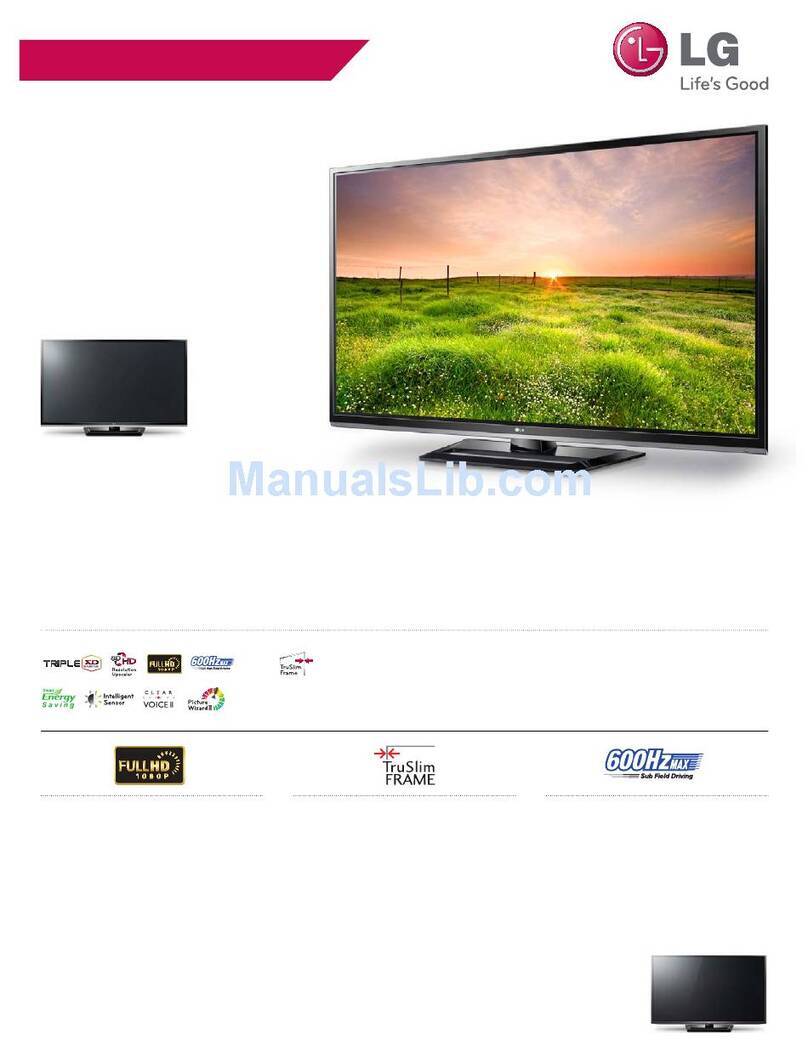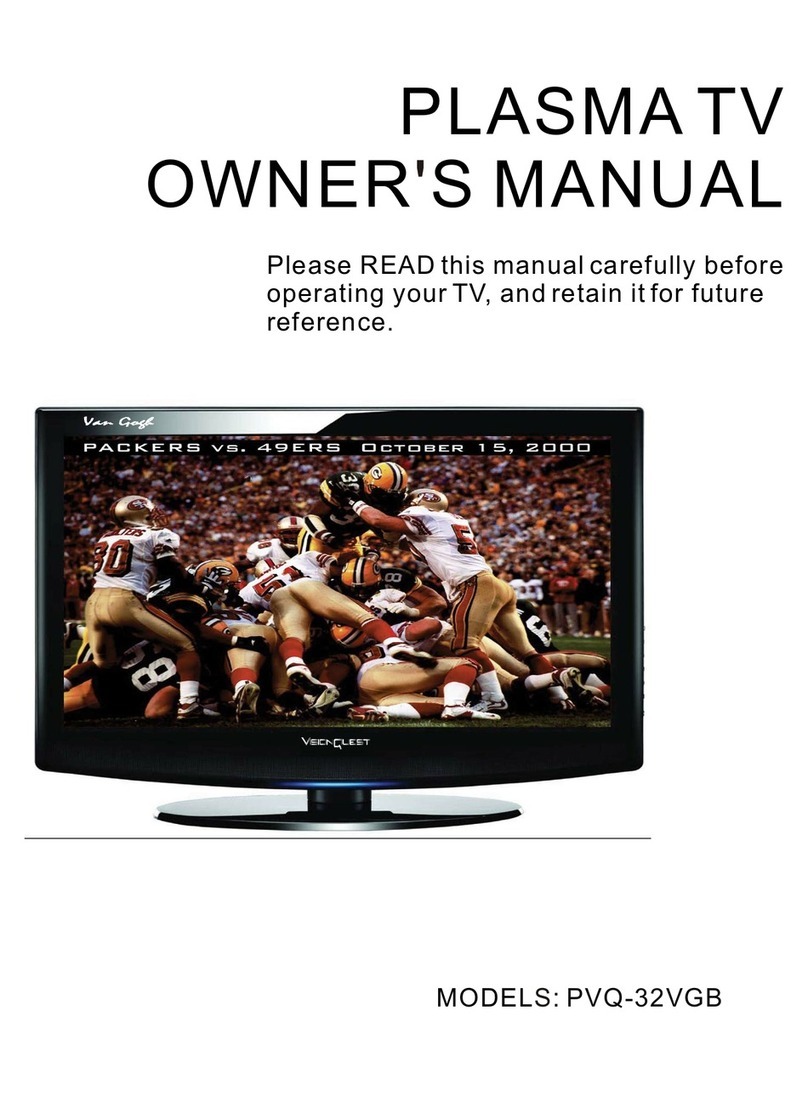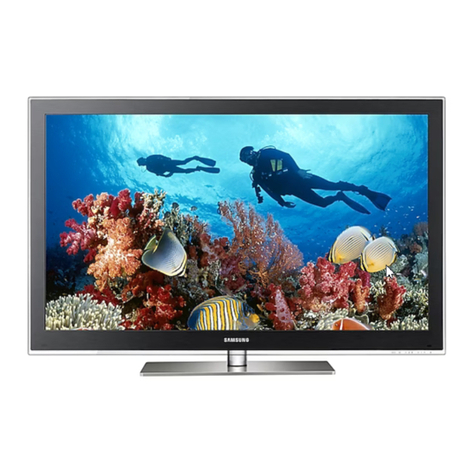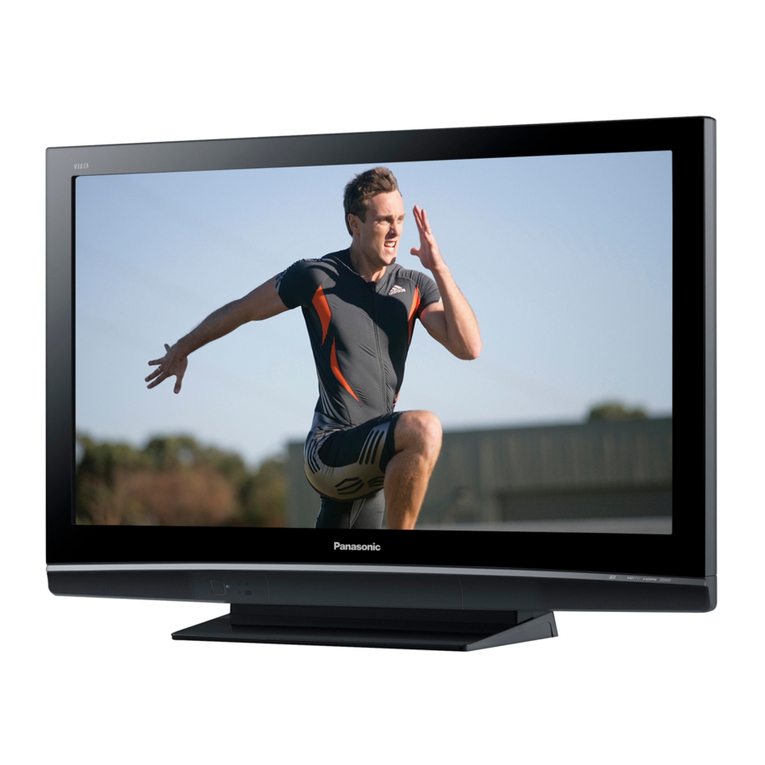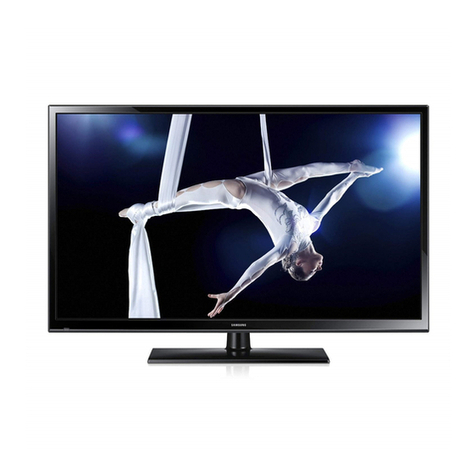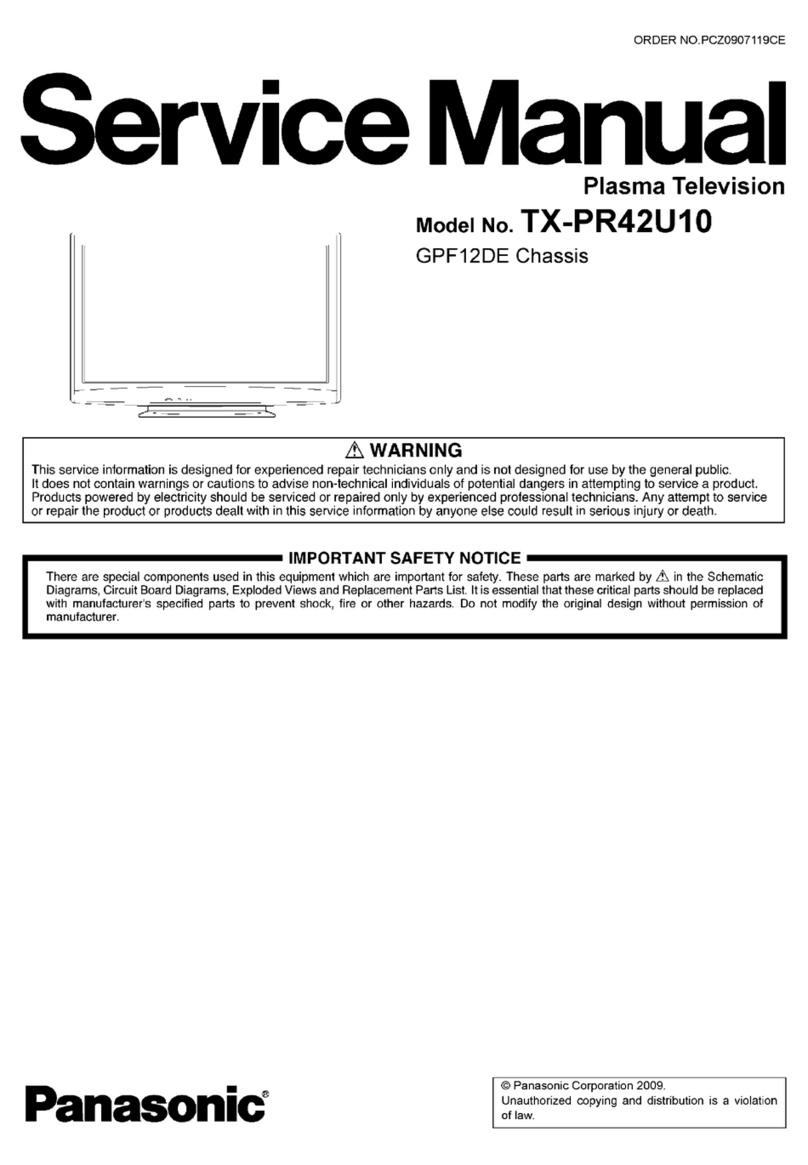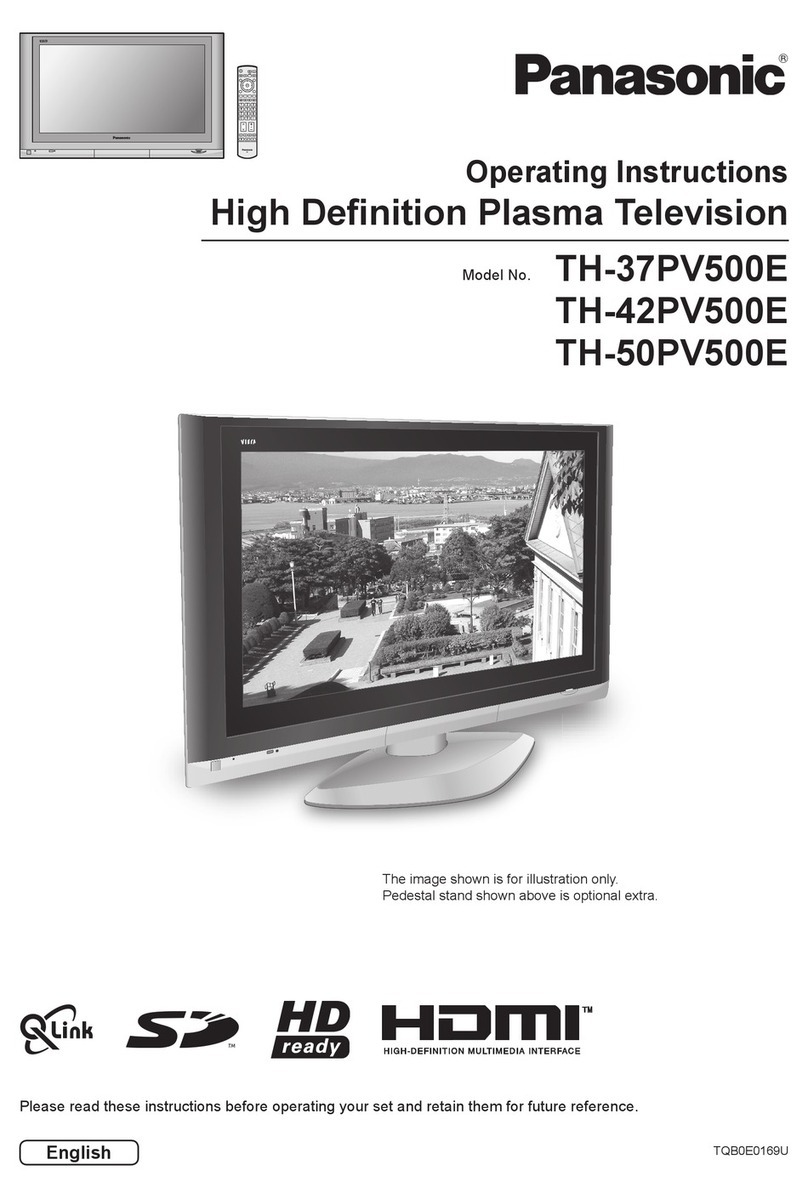Sylvania 6842THG User manual

SERVICE MANUAL
Main Section
ISpecifications
IAdjustment Procedures
ITroubleshooting
ISchematic Diagrams
ICBA’s
IExploded Views
IParts List
Plasma Display Module Section
IPrecautions
IName & Function
IDisassembling / Assemblingt
IOperation Check
IWiring Diagram
42″DIGITAL/ANALOG
PLASMA DISPLAY TV
6842THG
VOLUME CHANNEL
INPUT SELECT /
ENTER
STANDBYSETUP
ON POWER

IMPORTANT SAFETY NOTICE
Proper service and repair is important to the safe, reliable operation of all
Funai Equipment. The service procedures recommended by Funai and
described in this service manual are effective methods of performing
service operations. Some of these service special tools should be used
when and as recommended.
It is important to note that this service manual contains various CAUTIONS
and NOTICES which should be carefully read in order to minimize the risk
of personal injury to service personnel. The possibility exists that improper
service methods may damage the equipment. It also is important to
understand that these CAUTIONS and NOTICES ARE NOT EXHAUSTIVE.
Funai could not possibly know, evaluate and advice the service trade of all
conceivable ways in which service might be done or of the possible
hazardous consequences of each way. Consequently, Funai has not
undertaken any such broad evaluation. Accordingly, a servicer who uses a
service procedure or tool which is not recommended by Funai must first
use all precautions thoroughly so that neither his safety nor the safe
operation of the equipment will be jeopardized by the service method
selected.

MAIN SECTION
42″DIGITAL/ANALOG
PLASMA DISPLAY TV
6842THG
TABLE OF CONTENTS
Specifications . . . . . . . . . . . . . . . . . . . . . . . . . . . . . . . . . . . . . . . . . . . . . . . . . . . . . . . . . . . . . . . . . . . . . . . . . 1-1-1
Important Safety Precautions . . . . . . . . . . . . . . . . . . . . . . . . . . . . . . . . . . . . . . . . . . . . . . . . . . . . . . . . . . . . . 1-2-1
Standard Notes for Servicing . . . . . . . . . . . . . . . . . . . . . . . . . . . . . . . . . . . . . . . . . . . . . . . . . . . . . . . . . . . . . 1-3-1
Basic Setup and Operating Guide. . . . . . . . . . . . . . . . . . . . . . . . . . . . . . . . . . . . . . . . . . . . . . . . . . . . . . . . . . 1-4-1
Cabinet Disassembly Instructions. . . . . . . . . . . . . . . . . . . . . . . . . . . . . . . . . . . . . . . . . . . . . . . . . . . . . . . . . . 1-5-1
Electrical Adjustment Instructions . . . . . . . . . . . . . . . . . . . . . . . . . . . . . . . . . . . . . . . . . . . . . . . . . . . . . . . . . . 1-6-1
How to initialize the Television. . . . . . . . . . . . . . . . . . . . . . . . . . . . . . . . . . . . . . . . . . . . . . . . . . . . . . . . . . . . . . 1-7-1
Troubleshooting. . . . . . . . . . . . . . . . . . . . . . . . . . . . . . . . . . . . . . . . . . . . . . . . . . . . . . . . . . . . . . . . . . . . . . . . 1-8-1
Block Diagrams . . . . . . . . . . . . . . . . . . . . . . . . . . . . . . . . . . . . . . . . . . . . . . . . . . . . . . . . . . . . . . . . . . . . . . . . 1-9-1
Schematic Diagrams / CBA’s and Test Points. . . . . . . . . . . . . . . . . . . . . . . . . . . . . . . . . . . . . . . . . . . . . . . . 1-10-1
Waveforms . . . . . . . . . . . . . . . . . . . . . . . . . . . . . . . . . . . . . . . . . . . . . . . . . . . . . . . . . . . . . . . . . . . . . . . . . . 1-11-1
Wiring Diagram . . . . . . . . . . . . . . . . . . . . . . . . . . . . . . . . . . . . . . . . . . . . . . . . . . . . . . . . . . . . . . . . . . . . . . . 1-12-1
IC Pin Functions . . . . . . . . . . . . . . . . . . . . . . . . . . . . . . . . . . . . . . . . . . . . . . . . . . . . . . . . . . . . . . . . . . . . . . 1-13-1
Lead Identifications . . . . . . . . . . . . . . . . . . . . . . . . . . . . . . . . . . . . . . . . . . . . . . . . . . . . . . . . . . . . . . . . . . . . 1-14-1
Exploded Views. . . . . . . . . . . . . . . . . . . . . . . . . . . . . . . . . . . . . . . . . . . . . . . . . . . . . . . . . . . . . . . . . . . . . . . 1-15-1
Mechanical Parts List . . . . . . . . . . . . . . . . . . . . . . . . . . . . . . . . . . . . . . . . . . . . . . . . . . . . . . . . . . . . . . . . . . 1-16-1
Electrical Parts List . . . . . . . . . . . . . . . . . . . . . . . . . . . . . . . . . . . . . . . . . . . . . . . . . . . . . . . . . . . . . . . . . . . . 1-17-1
Main Section
ISpecifications
IAdjustment Procedures
ITroubleshooting
ISchematic Diagrams
ICBA’s
IExploded Views
IParts List

1-1-1 L0700SP
SPECIFICATIONS
< PANEL >
< TUNER / NTSC >
< TUNER / ATSC >
< VIDEO >
< AUDIO>
All items are measured across 8 Ωload at speaker output terminal.
Description Condition Unit Nominal Limit
1. Native Pixel Resolusion Horizontal
Vertical pixels
pixels 1024
768 ---
---
2. Brightness(w/ filter) cd/m270 ---
3. Output Colors --- 16.7mil. ---
Description Condition Unit Nominal Limit
1. AFT Pull-in Range MHz
MHz +2.3
-2.3 +2.1
-2.1
2. Syncronizing Sens. ch.4
ch.10
ch.41
dBu
dBu
dBu
---
---
---
20
20
23
Description Condition Unit Nominal Limit
1. Received Freq. Range (-28dBm) kHz
kHz ---
--- +100
-100
2. ATSC Dynamic Range (min / max) ch.4
ch.10
ch.41
dBm
dBm
dBm
---
---
---
-76/0
-76/0
-74/+4
Description Condition Unit Nominal Limit
1. Over Scan Horizontal
Vertical %
%7
5---
---
2. Color Temperature x
y°K 12000
0.272
0.278 ±10%
±10%
3. Resolution [composite video] Horizontal
Vertical line
line 400
350 ---
---
Description Condition Unit Nominal Limit
1. Audio Output Power 10% THD: Lch/Rch W 5.0/5.0 4.5/4.5
2. Audio Distortion 500mW: Lch/Rch % 0.5/0.5 2.0/2.0
3. Audio Freq. Response (NTSC) 20 - 1kHz
1k - 11kHz
*1kHz : 0dB
dB
dB -1 to +5
-8 to +1 ---
---

1-1-2 L0700SP
Note:Nominal specifications represent the design specifications. All units should be able to approximate these.
Some will exceed and some may drop slightly below these specifications. Limit specifications represent the abso-
lute worst condition that still might be considered acceptable. In no case should a unit fail to meet limit specifica-
tions.
DIMENSIONS
4. Audio Freq. Response (Others) 20 - 1kHz
1k - 20kHz
*1kHz : 0dB
dB
dB -1 to +5
-3 to +1 ---
---
Description Condition Unit Nominal Limit
330
115
1054
966
563
734
654
780

1-2-1 L0604IMP
IMPORTANT SAFETY PRECAUTIONS
Prior to shipment from the factory, our products are strictly inspected for recognized product safety and electrical
codes of the countries in which they are to be sold. However, in order to maintain such compliance, it is equally
important to implement the following precautions when a set is being serviced.
Safety Precautions for Monitor Circuit
1. Before returning an instrument to the custom-
er, always make a safety check of the entire instru-
ment, including, but not limited to, the following
items:
a. Be sure that no built-in protective devices are de-
fective and have been defeated during servicing.
(1) Protective shields are provided on this chassis
to protect both the technician and the customer.
Correctly replace all missing protective shields, in-
cluding any removed for servicing convenience. (2)
When reinstalling the chassis and/or other assem-
bly in the cabinet, be sure to put back in place all
protective devices, including but not limited to,
nonmetallic control knobs, insulating fishpapers,
adjustment and compartment covers/shields, and
isolation resistor/capacitor networks. Do not oper-
ate this instrument or permit it to be operated
without all protective devices correctly in-
stalled and functioning. Servicers who defeat
safety features or fail to perform safety checks
may be liable for any resulting damage.
b. Be sure that there are no cabinet openings through
which an adult or child might be able to insert their
fingers and contact a hazardous voltage. Such
openings include, but are not limited to, (1) exces-
sively wide cabinet ventilation slots, and (2) an im-
properly fitted and/or incorrectly secured cabinet
back cover.
c. Leakage Current Cold Check - With the instru-
ment AC plug removed from any AC source, con-
nect an electrical jumper across the two AC plug
prongs. Place the instrument AC switch in the on
position. Connect one lead of an ohmmeter to the
AC plug prongs tied together and touch the other
ohmmeter lead in turn to each exposed metallic
cabinet part. If the measured resistance is less
than 1.0 megohm or greater than 5.2 megohm, an
abnormality exists that must be corrected before
the instrument is returned to the customer. Repeat
this test with the instrument AC switch in the off po-
sition.
d. Leakage Current Hot Check - With the instru-
ment completely reassembled, plug the AC line
cord directly into a 120V AC outlet. (Do not use an
isolation transformer during this test.) Use a leak-
age current tester or a metering system that com-
plies with American National Standards Institute
(ANSI) C101.1 Leakage Current for Appliances.
With the instrument AC switch first in the on posi-
tion and then in the off position, measure from a
known earth ground (metal water pipe, conduit,
etc.) to all exposed metal parts of the instrument
(antennas, handle brackets, metal cabinet, screw
heads, metallic overlays, control shafts, etc.), es-
pecially any exposed metal parts that offer an elec-
trical return path to the chassis. Any current
measured must not exceed 0.75 milli-ampere. Re-
verse the instrument power cord plug in the outlet
and repeat the test.
ANY MEASUREMENTS NOT WITHIN THE LIMITS
SPECIFIED HEREIN INDICATE A POTENTIAL
SHOCK HAZARD THAT MUST BE ELIMINATED
BEFORE RETURNING THE INSTRUMENT TO
THE CUSTOMER OR BEFORE CONNECTING
THE ANTENNA OR ACCESSORIES.
2. Read and comply with all caution and safety-relat-
ed notes on or inside the cabinet, or on the chas-
sis,
3. Design Alteration Warning - Do not alter or add
to the mechanical or electrical design of this mon-
itor. Design alterations and additions, including,
but not limited to circuit modifications and the ad-
dition of items such as auxiliary audio and/or video
output connections, might alter the safety charac-
teristics of this receiver and create a hazard to the
user. Any design alterations or additions will void
the manufacturer's warranty and may make you,
the servicer, responsible for personal injury or
property damage resulting therefrom.
4. Hot Chassis Warning -
a. Some monitor chassis are electrically connected
directly to one conductor of the AC power cord and
maybe safety-serviced without an isolation trans-
former only if the AC power plug is inserted so that
the chassis is connected to the ground side of the
AC power source. To confirm that the AC power
plug is inserted correctly, with an AC voltmeter,
measure between the chassis and a known earth
ground. If a voltage reading in excess of 1.0V is
obtained, remove and reinsert the AC power plug
in the opposite polarity and again measure the
voltage potential between the chassis and a
known earth ground.

1-2-2 L0604IMP
b. Some monitor chassis normally have 85V
AC(RMS) between chassis and earth ground re-
gardless of the AC plug polarity. This chassis can
be safety-serviced only with an isolation transform-
er inserted in the power line between the receiver
and the AC power source, for both personnel and
test equipment protection.
c. Some monitor chassis have a secondary ground
system in addition to the main chassis ground.
This secondary ground system is not isolated from
the AC power line. The two ground systems are
electrically separated by insulation material that
must not be defeated or altered.
5. Observe original lead dress. Take extra care to as-
sure correct lead dress in the following areas:a.
near sharp edges,b. near thermally hot parts-be
sure that leads and components do not touch ther-
mally hot parts,c. the AC supply,d. high voltage,
and,e. antenna wiring. Always inspect in all areas
for pinched, out of place, or frayed wiring. Check
AC power cord for damage.
6. Components, parts, and/or wiring that appear to
have overheated or are otherwise damaged
should be replaced with components, parts, or wir-
ing that meet original specifications. Additionally,
determine the cause of overheating and/or dam-
age and, if necessary, take corrective action to re-
move any potential safety hazard.
7 Product Safety Notice - Some electrical and me-
chanical parts have special safety-related charac-
teristics which are often not evident from visual
inspection, nor can the protection they give neces-
sarily be obtained by replacing them with compo-
nents rated for higher voltage, wattage, etc.. Parts
that have special safety characteristics are identi-
fied by a ( #) on schematics and in parts lists. Use
of a substitute replacement that does not have the
same safety characteristics as the recommended
replacement part might create shock, fire, and/or
other hazards. The product's safety is under re-
view continuously and new instructions are issued
whenever appropriate. Prior to shipment from the
factory, our products are strictly inspected to con-
firm they comply with the recognized product safe-
ty and electrical codes of the countries in which
they are to be sold. However, in order to maintain
such compliance, it is equally important to imple-
ment the following precautions when a set is being
serviced.
General Caution of Plasma Display
1. Since the Panel module and front filter are made of
glass, sufficient care shall be taken when handling
the broken module and filter in order to avoid inju-
ry.
2. If necessary to replace Panel module, this work
must be started after the panel module and the
AC/DC Power supply becomes sufficiently cool.
3. Special care must be taken with the display area to
avoid damaging its surface.
4. The Panel Module shall not be touched with bare
hands to protect its surface from stains.
5. It is recommended to use clean soft gloves during
the replacing work of the Panel module in order to
protect, not only the display area of the panel mod-
ule but also the serviceman.
6. The Chip Tube of the panel module (located upper
left of the back of the panel module) and flexible
cables connecting Panel glasses to the drive cir-
cuitry Printed Wiring Boards (P.W.B.) are very
weak, so sufficient care must be taken to prevent
breaking or cutting any of these. If the Chip Tube
breaks the panel module will never work, replace-
ment for a new plasma panel module will be need-
ed.
7. Signal, power supply P.W.B.’s and PDP driving cir-
cuits P.W.B.’s are assembled on the rear side of
the PDP module, take special care with this fragile
circuitry; particularly, Flexible Printed Circuits
bonded to surrounding edges of the glass panel.
They are not strong enough to withstand harsh
outer mechanical forces. Avoid touching the flexi-
ble printed circuits by not only your hands, but also
tools, chassis, or any other object. Extreme bend-
ing of the connectors must be avoided too. In case
the flexible printed circuits are damaged, the cor-
responding addressed portions of the screen will
not be lit and exchange of a glass panel will be re-
quired.

1-2-3 L0604IMP
PDP Module Handling
When there is need to replace a broken PDP module
which is the displaying device from the Plasma display
unit, consider the following:
1. When carrying the PDP module, two persons
should stand at both shorter-edge sides of the
glass-panel and transport it with their palms. Avoid
touching the Flexible Printed Circuits or the chip
tube on the corner of the glass-panel. Handle only
by the surface of the glass panel.
2. When carrying PDP module, watch surrounding
objects, such as tables, and also do not carry it
alone since it may be dangerous and it will be dam-
aged due to excessive stress to the module (glass-
panel).
3. Please do not stand the module with the edge of
the glass-panel on the table since this might result
in damage to the glass-panel and/or flexible print-
ed circuits due to excessive stress to the module
(glass-panel).
Precautions during Servicing
A. Parts identified by the ( #) symbol are critical for
safety.
Replace only with part number specified.
B. In addition to safety, other parts and assemblies
are specified for conformance with regulations ap-
plying to spurious radiation. These must also be
replaced only with specified replacements.
Examples: RF converters, RF cables, noise block-
ing capacitors, and noise blocking filters, etc.
C. Use specified internal wiring. Note especially:
1) Wires covered with PVC tubing
2) Double insulated wires
3) High voltage leads
D. Use specified insulating materials for hazardous
live parts. Note especially:
1) Insulation Tape
2) PVC tubing
3) Spacers
4) Insulators for transistors.
E. When replacing AC primary side components
(transformers, power cord, etc.), wrap ends of
wires securely about the terminals before solder-
ing.
F. Observe that the wires do not contact heat produc-
ing parts (heatsinks, oxide metal film resistors, fus-
ible resistors, etc.)
G. Check that replaced wires do not contact sharp
edged or pointed parts.
H. Also check areas surrounding repaired locations.
I. Use care that foreign objects (screws, solder drop-
lets, etc.) do not remain inside the set.
J. When connecting or disconnecting the internal
connectors, first, disconnect the AC plug from the
AC supply outlet.

1-2-4 L0604IMP
Safety Check after Servicing
Examine the area surrounding the repaired location
for damage or deterioration. Observe that screws,
parts and wires have been returned to original posi-
tions. Afterwards, perform the following tests and con-
firm the specified values in order to verify compliance
with safety standards.
1. Clearance Distance
When replacing primary circuit components, confirm
specified clearance distance (d) and (d') between sol-
dered terminals, and between terminals and surround-
ing metallic parts. (See Fig. 1)
Table 1 : Ratings for selected area
Note: This table is unofficial and for reference only. Be
sure to confirm the precise values.
2. Leakage Current Test
Confirm the specified (or lower) leakage current be-
tween B (any two parts or contacts, between any part
or contact and either pole of the power cord plug
prongs) and externally exposed accessible parts (RF
terminals, antenna terminals, video and audio input
and output terminals, microphone jacks, earphone
jacks, etc.) is lower than or equal to the specified val-
ue in the table below.
Measuring Method: (Power ON)
Insert load Z between B (any two parts or contacts,
between any part or contact and either pole of the
power cord plug prongs) and exposed accessible
parts. Use an AC voltmeter to measure across both
terminals of load Z. See Fig. 2 and following table.
Table 2: Leakage current ratings for selected areas
Note: This table is unofficial and for reference only. Be sure to confirm the precise values.
AC Line Voltage Region Clearance
Distance (d) (d')
110 to 130 V USA or
CANADA
≥3.2 mm
(0.126 inches)
Fig. 1
Chassis or Secondary Conductor
Primary Circuit
d' d
AC Voltmeter
(High Impedance)
Exposed Accessible Metal Part
BOne of Power Cord
Plug Prongs
Z
1.5kΩ0.15µF
Fig. 2
AC Line Voltage Region Load Z Leakage Current (i) Earth Ground (B) to:
110 to 130 V USA
0.15µF CAP. & 1.5kΩ
RES. connected in
parallel
i≤0.75mA peaks Exposed accessible
parts

1-3-1 L14STA2
STANDARD NOTES FOR SERVICING
Circuit Board Indications
a. The output pin of the 3 pin Regulator ICs is indicat-
ed as shown.
b. For other ICs, pin 1 and every fifth pin are indicat-
ed as shown.
c. The 1st pin of every male connector is indicated as
shown.
Pb (Lead) Free Solder
Pb free mark will be found on PCBs which use Pb
free solder. (Refer to figure.) For PCBs with Pb
free mark, be sure to use Pb free solder. For PCBs
without Pb free mark, use standard solder.
How to Remove / Install Flat Pack-IC
1. Removal
With Hot-Air Flat Pack-IC Desoldering Machine:
(1) Prepare the hot-air flat pack-IC desoldering ma-
chine, then apply hot air to the Flat Pack-IC (about
5 to 6 seconds). (Fig. S-1-1)
(2) Remove the flat pack-IC with tweezers while ap-
plying the hot air.
(3) Bottom of the flat pack-IC is fixed with glue to the
CBA; when removing entire flat pack-IC, first apply
soldering iron to center of the flat pack-IC and heat
up. Then remove (glue will be melted). (Fig. S-1-6)
(4) Release the flat pack-IC from the CBA using twee-
zers. (Fig. S-1-6)
Caution:
1. The Flat Pack-IC shape may differ by models. Use
an appropriate hot-air flat pack-IC desoldering ma-
chine, whose shape matches that of the Flat Pack-
IC.
2. Do not supply hot air to the chip parts around the
flat pack-IC for over 6 seconds because damage
to the chip parts may occur. Put masking tape
around the flat pack-IC to protect other parts from
damage. (Fig. S-1-2)
Top View
Out In
Bottom View
Input
5
10
Pin 1
Pin 1
Pb free mark
Fig. S-1-1

1-3-2 L14STA2
3. The flat pack-IC on the CBA is affixed with glue, so
be careful not to break or damage the foil of each
pin or the solder lands under the IC when remov-
ing it.
With Soldering Iron:
(1) Using desoldering braid, remove the solder from
all pins of the flat pack-IC. When you use solder
flux which is applied to all pins of the flat pack-IC,
you can remove it easily. (Fig. S-1-3)
(2) Lift each lead of the flat pack-IC upward one by
one, using a sharp pin or wire to which solder will
not adhere (iron wire). When heating the pins, use
a fine tip soldering iron or a hot air desoldering ma-
chine.(Fig. S-1-4)
(3) Bottom of the flat pack-IC is fixed with glue to the
CBA; when removing entire flat pack-IC, first apply
soldering iron to center of the flat pack-IC and heat
up. Then remove (glue will be melted). (Fig. S-1-6)
(4) Release the flat pack-IC from the CBA using twee-
zers. (Fig. S-1-6)
With Iron Wire:
(1) Using desoldering braid, remove the solder from
all pins of the flat pack-IC. When you use solder
flux which is applied to all pins of the flat pack-IC,
you can remove it easily. (Fig. S-1-3)
(2) Affix the wire to a workbench or solid mounting
point, as shown in Fig. S-1-5.
(3) While heating the pins using a fine tip soldering
iron or hot air blower, pull up the wire as the solder
melts so as to lift the IC leads from the CBA con-
tact pads as shown in Fig. S-1-5.
Fig. S-1-2
Hot-air
Flat Pack-IC
Desoldering
Machine
CBA
Flat Pack-IC
Tweezers
Masking
Tape Fig. S-1-3
Flat Pack-IC Desoldering Braid
Soldering Iron
Fig. S-1-4
Fine Tip
Soldering Iron
Sharp
Pin

1-3-3 L14STA2
(4) Bottom of the flat pack-IC is fixed with glue to the
CBA; when removing entire flat pack-IC, first apply
soldering iron to center of the flat pack-IC and heat
up. Then remove (glue will be melted). (Fig. S-1-6)
(5) Release the flat pack-IC from the CBA using twee-
zers. (Fig. S-1-6)
Note:
When using a soldering iron, care must be taken to
ensure that the flat pack-IC is not being held by
glue. When the flat pack-IC is removed from the
CBA, handle it gently because it may be damaged
if force is applied.
2. Installation
(1) Using desoldering braid, remove the solder from
the foil of each pin of the flat pack-IC on the CBA
so you can install a replacement flat pack-IC more
easily.
(2) The "I" mark on the flat pack-IC indicates pin 1.
(See Fig. S-1-7.) Be sure this mark matches the 1
on the PCB when positioning for installation. Then
pre- solder the four corners of the flat pack-IC.
(See Fig. S-1-8.)
(3) Solder all pins of the flat pack-IC. Be sure that
none of the pins have solder bridges.
Fig. S-1-5
To Solid
Mounting Point
Soldering Iron
Iron Wire
or
Hot Air Blower
Fig. S-1-6
Fine Tip
Soldering Iron
CBA
Flat Pack-IC
Tweezers
Fig. S-1-7
Example :
Pin 1 of the Flat Pack-IC
is indicated by a " " mark.
Fig. S-1-8
Presolder
CBA
Flat Pack-IC

1-3-4 L14STA2
Instructions for Handling
Semiconductors
Electrostatic breakdown of the semiconductors may
occur due to a potential difference caused by electro-
static charge during unpacking or repair work.
1. Ground for Human Body
Be sure to wear a grounding band (1MΩ) that is prop-
erly grounded to remove any static electricity that may
be charged on the body.
2. Ground for Workbench
Be sure to place a conductive sheet or copper plate
with proper grounding (1MΩ) on the workbench or
other surface, where the semiconductors are to be
placed. Because the static electricity charge on cloth-
ing will not escape through the body grounding band,
be careful to avoid contacting semiconductors with
your clothing.
CBA
<Incorrect>
Grounding Band
Conductive Sheet or
Copper Plate
1MΩ
1MΩ
<Correct>
CBA

1-4-1 L0700IB
BASIC SETUP AND OPERATING GUIDE

1-4-2 L0700IB

1-4-3 L0700IB

1-4-4 L0700IB

1-4-5 L0700IB

1-4-6 L0700IB

1-5-1 L0700DC
CABINET DISASSEMBLY INSTRUCTIONS
1. Disassembly Flowchart
This flowchart indicates the disassembly steps for the
cabinet parts, and the CBA in order to gain access to
item(s) to be serviced. When reassembling, follow the
steps in reverse order. Bend, route and dress the
cables as they were.
2. Disassembly Method
[7] Jack CBA
[6] Jack Holder
[5] Jack Bracket
[8] AC Inlet
[9] Analog CBA
[3] Fan
[2] Fan Holder
[1] Rear Cabinet
[10] Digital CBA
Unit
[12] Jack Cover
[13] PCB Box
[22] PCB Holder
[29] Switch CBA
[11-2] Stand
[11-3] Stand
Base
[11-1] Stand
Cover
[4] PCB Box
Cover
[14] Speaker
Box Assembly
[15] PDP Panel
Assembly
[18] Optical
Filter
[24] Panel
Holder (S)
[26] Panel
Holder (L)
[25] Panel
Holder (U)
[27] Decoration
Panel
[28] Switch CBA
Holder
[19] Chassis
Bracket
[17]
Filter Holder (S)
Assembly
[16]
Filter Holder (L)
Assembly
[20] Sub Power
Supply CBA
[21] Power
Supply CBA
[23] Plasma
Display Module
[30] Front
Cabinet
[11] Stand
Assembly
ID/
Loc.
No.
Part
Removal
Fig.
No.
Remove/*Unhook/
Unlock/Release/
Unplug/Desolder
Note
1Rear
Cabinet D1 24(S-1) ---
2 Fan Holder D2 4(S-2) ---
3Fan D2
D11 4(S-3), *CN2501 ---
4PCB Box
Cover D2 10(S-4) ---
5Jack
Bracket D2 2(S-5) ---
6 Jack Holder D2 2(S-6) ---
7JackCBA D2
D10 2(S-7), (S-8), *CN701 ---
8 AC Inlet D3 2(S-9) ---
9Analog
CBA D3
D10
7(S-10), 4(S-11),
*CN702, *CN703,
*CN704, *CN705,
*CN708, *CN801,
*CN802, *CN1111,
*CN1112, *CN1113,
*CN1116, *CN2000
---
[14-6] Speaker
[14-6] Speaker
[14-7] Tweeter
Speaker
[14] Speaker Box
Assembly
[14-8] Speaker
Front (R)
[14-9] Speaker
Front (L)
[14-1] Speaker
Bracket
[14-2] Speaker
Rear Cover (R)
[14-3] Speaker
Rear Cover (L)
[14-4] Network 1
CBA
[14-5] Network 2
CBA
[14-7] Tweeter
Speaker
Other manuals for 6842THG
3
Table of contents
Other Sylvania Plasma TV manuals




